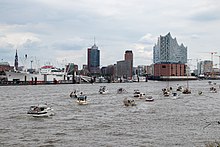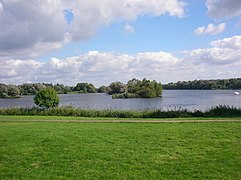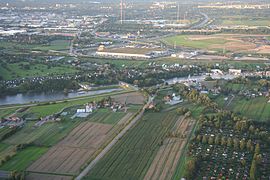Dove Elbe
| Dove Elbe | ||
|
Horticultural company on the Dove Elbe |
||
| Data | ||
| location | Hamburg , Germany | |
| River system | Elbe | |
| Drain over | Elbe → North Sea | |
| muzzle | in the North Elbe coordinates: 53 ° 30 '22 " N , 10 ° 3' 34" E 53 ° 30 '22 " N , 10 ° 3' 34" E
|
|
| length | 18 km | |
| Catchment area | 506 km² | |
The Dove Elbe (from Low German dov "deaf") is an 18 kilometer long tributary of the Elbe in southeast Hamburg .
History and course
The Dove Elbe was separated from the main river of the Lower Elbe in 1437/1438 at Gammer Ort by a connecting dike between the islands of Altengamme and Neuengamme in order to improve the navigation of the Port of Hamburg . Today it begins shortly behind the dike as a narrow ditch and initially runs in a north-westerly direction through the Hamburg Vierlande .
Before the Neuengammer Blue Bridge, the Neuengammer branch canal goes off to the left . From 1940 to 1942 inmates of the Neuengamme concentration camp had to dig this canal and widen the Dove Elbe from here. The bricks made in the warehouse's clinker factory were to be transported to Hamburg by barges on the waterway created in this way.
From Curslack onwards , the Dove Elbe is navigable with larger sports boats. Shortly after that, the Neuengammer breakthrough joins from the left, which forms a connection to the Gose Elbe - although it is only accessible by canoe .
Behind the Dove-Elbe-lock , which is only still acts as Hochwassersperrtor and normally open, flows from the right to Bergedorf leading Schleusengraben one, the water from the north runs Bille leads. The lock ditch was dug in 1443 in order to supply the Elbarme directly in front of Hamburg with more water via the Dove Elbe. The Schleusengraben and thus the city center of Bergedorf are accessible via the Krapphofschleuse . Canoes can use a boat tow under a road bridge to the east . The Dove Elbe then flows further west through the Hamburg marshland , separating the Allermöhe area from the Reitbrook island on the south bank .
Between the north-western tip of Reitbrooks with the nature reserve Die Reit and Ochsenwerder , the Gose Elbe , another old arm of the Elbe, flows from the south . The Dove Elbe is widened in front of and behind the mouth to form an elongated lake; it is designated as a regatta course for rowing and canoeing (see water sports center Hamburg-Allermöhe ). Immediately to the north of this is the Eichbaumsee , a quarry pond that was created when the A 25 was being built and was popular as a swimming lake in summer. Bathing has been banned there since 2007.
At the Tatenberg Bay, the Dove Elbe bends north and flows around the former island of Tatenberg in a wide arc. Before they were dyed, another branch of the Elbe ran to the southwest between Ochsenwerder and Tatenberg and Spadenland , which again met the main stream in the south at Moorwerder .
Behind the Tatenberger Schleuse, the Dove Elbe has flowed together with the Norderelbe since 1579 , which today forms the northern main stream of the Elbe in the Hamburg area. The estuary and the Norderelbe itself were created by cutting through the island of Spadenland to the south (Spadenlander Durchstich ) and the dike of the Dove Elbe, which actually continues to flow to the west. With this hydraulic engineering measure, too, Hamburg tried to supply its emerging port with water at the expense of Harburg, which was located on the then more abundant southern Elbe .
There are (as of 2019) considerations to open the Dove Elbe at the Tatenberger Schleuse and to connect it to the tidal events of the North Elbe. With a planned tidal range of around 2 meters, the Dove Elbe would in parts fall dry twice a day. These plans are being driven forward by the Forum Tideelbe, founded in 2016, which is looking for compensatory measures for problems that have arisen as a result of decades of hydraulic engineering work in the Lower Elbe, such as the steep rise in the tidal range, increased flow velocity and sediment deposits in the Port of Hamburg. Whether this opening of the Dove Elbe would have beneficial or harmful effects in terms of nature conservation or local recreation is controversial. Most recently, on July 25, 2020, opponents of the opening protested on around 100 boats in front of the St. Pauli Landungsbrücken .
Wilhelmsburger Dove Elbe
Behind the dike, which today limits the island of Wilhelmsburg to the east, the original course of the Dove Elbe continues in a westerly direction in the Georgswerder Schleusengraben and continues from Kirchdorfer Straße under the name Dove Wetter and Wilhelmsburger Dove Elbe ; this separates the former islands of Georgswerder in the north and Stillhorn in the south. The Wilhelmsburger Dove Elbe flows over the Ernst-August-Kanal into the Reiherstieg , a waterway running in south-north direction in the area of the Hamburg harbor, which in turn flows into the North Elbe opposite the Baumall .
The current of the Dove Elbe is weak because it has no significant gradient. Their water is of good quality.
Fish fauna
The Dove Elbe, similar to the Gose Elbe , is an old body of water that is heavily herbaceous and covered with thick carpets of pond roses . From the Krapphof sluice to the mouth of the Elbe, it is leased to the Angelsport-Verband Hamburg eV It is one of the so-called Hamburg Association waters, in which members the fishing clubs affiliated to the association can practice the sport of fishing. The Hohe Reit nature reserve is excluded from fishing . The following fish species can be in the 15 km long river beangeln: carp , tench , roach , rudd , ide , bream , pike , perch , asp , perch and eels . The baiting of fried fish , for reasons of eutrophication prohibited.
Linguistic
The river name is occasionally also spelled with a hyphen ( Dove-Elbe ), since the adjectival use of "dov" is not immediately recognizable in High German. It is also disputed whether the river name should be declined (compare the current of the Dove Elbe , but the current of the Black Elbe ).
Web links
swell
- ↑ City of Hamburg: Geotourist objects in Bergedorf - Damming Dove Elbe ( Memento from May 10, 2011 in the Internet Archive )
- ^ Karl-Ernst Behre : Landscape history of Northern Germany. Environment and settlement from the Stone Age to the present. Wachholtz, Neumünster 2008, ISBN 978-3-529-02499-3 , p. 121.
- ^ Forum Tideelbe catalog of measures
- ↑ Marco Carini: opening of the Dove-Elbe controversial: fight for the tidal range . In: The daily newspaper: taz . July 26, 2020, ISSN 0931-9085 ( taz.de [accessed on August 3, 2020]).
- ^ Elbe Wochenblatt, Region> Wilhelmsburg> Topics> Dove Elbe ( memento from October 24, 2016 in the Internet Archive ) accessed on October 24, 2016
- ↑ Homepage of the AV Hamburg eV ( Memento of the original from January 14, 2015 in the Internet Archive ) Info: The archive link was inserted automatically and has not yet been checked. Please check the original and archive link according to the instructions and then remove this notice.
- ↑ further association waters are Gose Elbe , Eichbaumsee , Alte Süderelbe , Hohendeicher See (Oortkatensee), Strom-Elbe 1–3, Hummelsee , parts of the Oste and Elbe Lateral Canal







